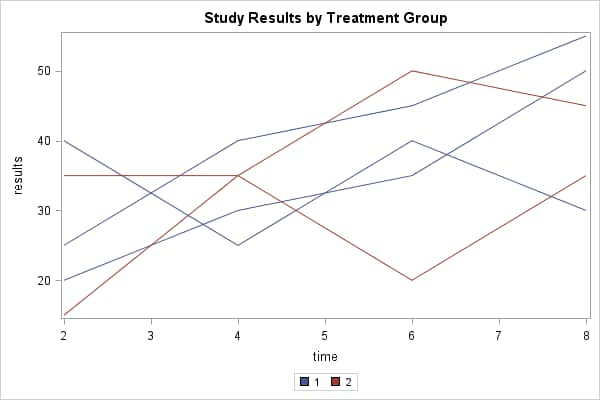Sample 52964: Create a spaghetti plot with the SGPLOT procedure
The sample code on the Full Code tab illustrates how to produce a "spaghetti plot" with the SGPLOT procedure. The syntax in this program requires the second maintenance release of SAS® 9.4 (TS1M2).
These sample files and code examples are provided by SAS Institute
Inc. "as is" without warranty of any kind, either express or implied, including
but not limited to the implied warranties of merchantability and fitness for a
particular purpose. Recipients acknowledge and agree that SAS Institute shall
not be liable for any damages whatsoever arising out of their use of this material.
In addition, SAS Institute will provide no support for the materials contained herein.
The sample code below illustrates how to produce a "spaghetti plot" with the SGPLOT procedure. The syntax in this program requires the second maintenance release of SAS® 9.4 (TS1M2).
data one;
input trt_group time subject results;
datalines;
1 2 100 20
1 4 100 30
1 6 100 35
1 8 100 50
1 2 200 40
1 4 200 25
1 6 200 40
1 8 200 30
1 2 300 25
1 4 300 40
1 6 300 45
1 8 300 55
2 2 400 15
2 4 400 35
2 6 400 50
2 8 400 45
2 2 500 35
2 4 500 35
2 6 500 20
2 8 500 35
;
run;
proc sgplot data=one;
title 'Study Results by Treatment Group';
series x=time y=results / group=subject grouplc=trt_group name='grouping';
keylegend 'grouping' / type=linecolor;
run;
These sample files and code examples are provided by SAS Institute
Inc. "as is" without warranty of any kind, either express or implied, including
but not limited to the implied warranties of merchantability and fitness for a
particular purpose. Recipients acknowledge and agree that SAS Institute shall
not be liable for any damages whatsoever arising out of their use of this material.
In addition, SAS Institute will provide no support for the materials contained herein.

| Type: | Sample |
| Topic: | SAS Reference ==> Procedures ==> SGPLOT
|
| Date Modified: | 2014-06-13 11:41:07 |
| Date Created: | 2014-05-12 15:43:18 |
Operating System and Release Information
| SAS System | Base SAS | Microsoft® Windows® for x64 | 9.4 TS1M2 | |
| Microsoft Windows 8 Pro 32-bit | 9.4 TS1M2 | |
| Microsoft Windows 8 Enterprise x64 | 9.4 TS1M2 | |
| Microsoft Windows 8 Pro x64 | 9.4 TS1M2 | |
| Microsoft Windows 8.1 Enterprise 32-bit | 9.4 TS1M2 | |
| Microsoft Windows 8.1 Enterprise x64 | 9.4 TS1M2 | |
| Microsoft Windows 8.1 Pro | 9.4 TS1M2 | |
| Microsoft Windows 8.1 Pro 32-bit | 9.4 TS1M2 | |
| Microsoft Windows Server 2008 | 9.4 TS1M2 | |
| Microsoft Windows Server 2008 R2 | 9.4 TS1M2 | |
| Microsoft Windows Server 2012 Datacenter | 9.4 TS1M2 | |
| Microsoft Windows Server 2012 R2 Datacenter | 9.4 TS1M2 | |
| z/OS | 9.4 TS1M2 | |
| Microsoft Windows 8 Enterprise 32-bit | 9.4 TS1M2 | |
| Microsoft® Windows® for 64-Bit Itanium-based Systems | 9.4 TS1M2 | |
| Z64 | 9.4 TS1M2 | |
| Microsoft Windows Server 2008 for x64 | 9.4 TS1M2 | |
| Microsoft Windows Server 2012 R2 Std | 9.4 TS1M2 | |
| Microsoft Windows Server 2012 Std | 9.4 TS1M2 | |
| Windows 7 Enterprise 32 bit | 9.4 TS1M2 | |
| Windows 7 Enterprise x64 | 9.4 TS1M2 | |
| Windows 7 Home Premium 32 bit | 9.4 TS1M2 | |
| Windows 7 Home Premium x64 | 9.4 TS1M2 | |
| Windows 7 Professional 32 bit | 9.4 TS1M2 | |
| Windows 7 Professional x64 | 9.4 TS1M2 | |
| Windows 7 Ultimate 32 bit | 9.4 TS1M2 | |
| Windows 7 Ultimate x64 | 9.4 TS1M2 | |
| 64-bit Enabled AIX | 9.4 TS1M2 | |
| 64-bit Enabled HP-UX | 9.4 TS1M2 | |
| 64-bit Enabled Solaris | 9.4 TS1M2 | |
| HP-UX IPF | 9.4 TS1M2 | |
| Linux for x64 | 9.4 TS1M2 | |
| Solaris for x64 | 9.4 TS1M2 | |





